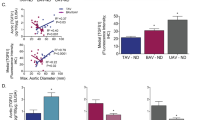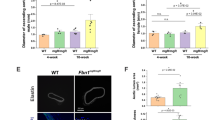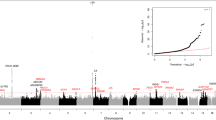Abstract
MicroRNAs are able to modulate gene expression in a range of diseases. We focused on microRNAs as potential contributors to the pathogenesis of ascending aorta (AA) dilatation in patients with stenotic tricuspid (TAV) or bicuspid aortic valve (BAV). Aortic specimens were collected from the ‘concavity’ and the ‘convexity’ of mildly dilated AAs and of normal AAs from heart transplant donors. Aortic RNA was analyzed through PCR arrays, profiling the expression of 84 microRNAs involved in cardiovascular disease. An in silico analysis identified the potential microRNA–mRNA interactions and the enriched KEGG pathways potentially affected by microRNA changes in dilated AAs. Distinct signatures of differentially expressed microRNAs are evident in TAV and BAV patients vs. donors, as well as differences between aortic concavity and convexity in patients only. MicroRNA changes suggest a switch of SMC phenotype, with particular reference to TAV concavity. MicroRNA changes potentially affecting mechanotransduction pathways exhibit a higher prevalence in BAV convexity and in TAV concavity, with particular reference to TGF-β1, Hippo, and PI3K/Akt/FoxO pathways. Actin cytoskeleton emerges as potentially affected by microRNA changes in BAV convexity only. MicroRNAs could play distinct roles in BAV and TAV aortopathy, with possible implications in diagnosis and therapy.




Similar content being viewed by others
References
JCS Joint Working Group (2013) Guidelines for diagnosis and treatment of aortic aneurysm and aortic dissection (JCS 2011): digest version. Circ J 77:789–828
Gillum RF (1995) Epidemiology of aortic aneurysm in the United States. J Clin Epidemiol 48:1289–1298
Karimi A, Milewicz DM (2016) Structure of the elastin-contractile units in the thoracic aorta and how genes that cause thoracic aortic aneurysms and dissections disrupt this structure. Can J Cardiol 32:26–34
Balistreri CR, Pisano C, Candore G, Maresi E, Codispoti M, Ruvolo G (2013) Focus on the unique mechanisms involved in thoracic aortic aneurysm formation in bicuspid aortic valve versus tricuspid aortic valve patients: clinical implications of a pilot study. Eur J Cardiothorac Surg 43:e180–e186
Malashicheva A, Kostina D, Kostina A, Irtyuga O, Voronkina I, Smagina L, Ignatieva E, Gavriliuk N, Uspensky V, Moiseeva O, Vaage J, Kostareva A (2016) Phenotypic and functional changes of endothelial and smooth muscle cells in thoracic aortic aneurysms. Int J Vasc Med 2016:3107879
Forte A, Della Corte A, Grossi M, Bancone C, Maiello C, Galderisi U, Cipollaro M (2013) Differential expression of proteins related to smooth muscle cells and myofibroblasts in human thoracic aortic aneurysm. Histol Histopathol 28:795–803
Forte A, Della Corte A, Grossi M, Bancone C, Provenzano R, Finicelli M, De Feo M, De Santo LS, Nappi G, Cotrufo M, Galderisi U, Cipollaro M (2013) Early cell changes and TGFbeta pathway alterations in the aortopathy associated with bicuspid aortic valve stenosis. Clin Sci (Lond) 124:97–108
Hinz B, Phan SH, Thannickal VJ, Prunotto M, Desmouliere A, Varga J, De Wever O, Mareel M, Gabbiani G (2012) Recent developments in myofibroblast biology: paradigms for connective tissue remodeling. Am J Pathol 180:1340–1355
Verma S, Siu SC (2014) Aortic dilatation in patients with bicuspid aortic valve. N Engl J Med 370:1920–1929
Page M, Mongeon FP, Stevens LM, Souliere V, Khairy P, El-Hamamsy I (2014) Aortic dilation rates in patients with biscuspid aortic valve: correlations with cusp fusion phenotype. J Heart Valve Dis 23:450–457
Phillippi JA, Green BR, Eskay MA, Kotlarczyk MP, Hill MR, Robertson AM, Watkins SC, Vorp DA, Gleason TG (2014) Mechanism of aortic medial matrix remodeling is distinct in patients with bicuspid aortic valve. J Thorac Cardiovasc Surg 147:1056–1064
Grewal N FR, Mulder BJ, Goumans MJ, Lindeman JH, Jongbloed MR, DeRuiter MC, Klautz RJ, Bogers AJ, Poelmann RE, Groot AC (2016) Histopathology of aortic complications in bicuspid aortic valve versus Marfan syndrome: relevance for therapy? Heart Vessels 31:795–806
Rocchiccioli S, Cecchettini A, Panesi P, Farneti PA, Mariani M, Ucciferri N, Citti L, Andreassi MG, Foffa I (2016) Hypothesis-free secretome analysis of thoracic aortic aneurysm reinforces the central role of TGF-beta cascade in patients with bicuspid aortic valve. J Cardiol (Epub ahead of print)
Aghabozorg Afjeh SS, Ghaderian SM (2013) The role of microRNAs in cardiovascular disease. Int J Mol Cell Med 2:50–57
Elia L, Quintavalle M, Zhang J, Contu R, Cossu L, Latronico MV, Peterson KL, Indolfi C, Catalucci D, Chen J, Courtneidge SA, Condorelli G (2009) The knockout of miR-143 and -145 alters smooth muscle cell maintenance and vascular homeostasis in mice: correlates with human disease. Cell Death Differ 16:1590–1598
Gao Y, Peng J, Ren Z, He NY, Li Q, Zhao XS, Wang MM, Wen HY, Tang ZH, Jiang ZS, Wang GX, Liu LS (2016) Functional regulatory roles of microRNAs in atherosclerosis. Clin Chim Acta 460:164–171
Forte A, Galderisi U, Cipollaro M, De Feo M, Corte AD (2016) Epigenetic regulation of TGF-beta1 signalling in dilative aortopathy of the thoracic ascending aorta. Clin Sci (Lond) 130:1389–1405
Freeze SL, Landis BJ, Ware SM, Helm BM (2016) Bicuspid aortic valve: a review with recommendations for genetic counseling. J Genet Couns (Epub ahead of print)
Albinsson S, Sward K (2013) Targeting smooth muscle microRNAs for therapeutic benefit in vascular disease. Pharmacol Res 75:28–36
Mohamed JS, Hajira A, Lopez MA, Boriek AM (2015) Genome-wide mechanosensitive microRNA (MechanomiR) screen uncovers dysregulation of their regulatory networks in the mdm mouse model of muscular dystrophy. J Biol Chem 290:24986–25011
Albinsson S, Bhattachariya A, Hellstrand P (2014) Stretch-dependent smooth muscle differentiation in the portal vein-role of actin polymerization, calcium signaling, and microRNAs. Microcirculation 21:230–238
Biros E, Moran CS, Wang Y, Walker PJ, Cardinal J, Golledge J (2014) microRNA profiling in patients with abdominal aortic aneurysms: the significance of miR-155. Clin Sci (Lond) 126:795–803
Jones JA, Stroud RE, O’Quinn EC, Black LE, Barth JL, Elefteriades JA, Bavaria JE, Gorman JH 3rd, Gorman RC, Spinale FG, Ikonomidis JS (2011) Selective microRNA suppression in human thoracic aneurysms: relationship of miR-29a to aortic size and proteolytic induction. Circ Cardiovasc Genet 4:605–613
Ikonomidis JS, Ivey CR, Wheeler JB, Akerman AW, Rice A, Patel RK, Stroud RE, Shah AA, Hughes CG, Ferrari G, Mukherjee R, Jones JA (2013) Plasma biomarkers for distinguishing etiologic subtypes of thoracic aortic aneurysm disease. J Thorac Cardiovasc Surg 145:1326–1333
Patuzzo C, Pasquali A, Malerba G, Trabetti E, Pignatti P, Tessari M, Faggian G (2012) A preliminary microRNA analysis of non syndromic thoracic aortic aneurysms. Balkan J Med Genet 15:51–55
Licholai S, Blaz M, Kapelak B, Sanak M (2016) Unbiased profile of microRNA expression in ascending aortic aneurysm tissue appoints molecular pathways contributing to the pathology. Ann Thorac Surg (Epub ahead of print)
Cotrufo M, Della Corte A, De Santo LS, Quarto C, De Feo M, Romano G, Amarelli C, Scardone M, Di Meglio F, Guerra G, Scarano M, Vitale S, Castaldo C, Montagnani S (2005) Different patterns of extracellular matrix protein expression in the convexity and the concavity of the dilated aorta with bicuspid aortic valve: preliminary results. J Thorac Cardiovasc Surg 130:504–511
Paraskevopoulou MD, Georgakilas G, Kostoulas N, Vlachos IS, Vergoulis T, Reczko M, Filippidis C, Dalamagas T, Hatzigeorgiou AG (2013) DIANA-microT web server v5.0: service integration into miRNA functional analysis workflows. Nucleic Acids Res 41:W169–W173
Pasta S, Rinaudo A, Luca A, Pilato M, Scardulla C, Gleason TG, Vorp DA (2013) Difference in hemodynamic and wall stress of ascending thoracic aortic aneurysms with bicuspid and tricuspid aortic valve. J Biomech 46:1729–1738
Choudhury N, Bouchot O, Rouleau L, Tremblay D, Cartier R, Butany J, Mongrain R, Leask RL (2009) Local mechanical and structural properties of healthy and diseased human ascending aorta tissue. Cardiovasc Pathol 18:83–91
Guzzardi DG, Barker AJ, van Ooij P, Malaisrie SC, Puthumana JJ, Belke DD, Mewhort HE, Svystonyuk DA, Kang S, Verma S, Collins J, Carr J, Bonow RO, Markl M, Thomas JD, McCarthy PM, Fedak PW (2015) Valve-related hemodynamics mediate human bicuspid aortopathy: insights from wall shear stress mapping. J Am Coll Cardiol 66:892–900
Mohamed SA, Noack F, Schoellermann K, Karluss A, Radtke A, Schult-Badusche D, Radke PW, Wenzel BE, Sievers HH (2012) Elevation of matrix metalloproteinases in different areas of ascending aortic aneurysms in patients with bicuspid and tricuspid aortic valves. ScientificWorldJournal 2012:806261
Kotlarczyk MP, Billaud M, Green BR, Hill JC, Shiva S, Kelley EE, Phillippi JA, Gleason TG (2016) Regional disruptions in endothelial nitric oxide pathway associated with bicuspid aortic valve. Ann Thorac Surg (Epub ahead of print)
Mohamed SA, Radtke A, Saraei R, Bullerdiek J, Sorani H, Nimzyk R, Karluss A, Sievers HH, Belge G (2012) Locally different endothelial nitric oxide synthase protein levels in ascending aortic aneurysms of bicuspid and tricuspid aortic valve. Cardiol Res Pract 2012:165957
Andreassi MG, Della Corte A (2016) Genetics of bicuspid aortic valve aortopathy. Curr Opin Cardiol (Epub ahead of print)
Boettger T, Beetz N, Kostin S, Schneider J, Kruger M, Hein L, Braun T (2009) Acquisition of the contractile phenotype by murine arterial smooth muscle cells depends on the Mir143/145 gene cluster. J Clin Invest 119:2634–2647
Xin M, Small EM, Sutherland LB, Qi X, McAnally J, Plato CF, Richardson JA, Bassel-Duby R, Olson EN (2009) MicroRNAs miR-143 and miR-145 modulate cytoskeletal dynamics and responsiveness of smooth muscle cells to injury. Genes Dev 23:2166–2178
Cordes KR, Sheehy NT, White MP, Berry EC, Morton SU, Muth AN, Lee TH, Miano JM, Ivey KN, Srivastava D (2009) miR-145 and miR-143 regulate smooth muscle cell fate and plasticity. Nature 460:705–710
Liu X, Cheng Y, Zhang S, Lin Y, Yang J, Zhang C (2009) A necessary role of miR-221 and miR-222 in vascular smooth muscle cell proliferation and neointimal hyperplasia. Circ Res 104:476–487
Shah AA, Gregory SG, Krupp D, Feng S, Dorogi A, Haynes C, Grass E, Lin SS, Hauser ER, Kraus WE, Shah SH, Hughes GC (2015) Epigenetic profiling identifies novel genes for ascending aortic aneurysm formation with bicuspid aortic valves. Heart Surg Forum 18:E134–E139
Hoffman BD, Grashoff C, Schwartz MA (2011) Dynamic molecular processes mediate cellular mechanotransduction. Nature 475:316–323
Yehya N, Yerrapureddy A, Tobias J, Margulies SS (2012) MicroRNA modulate alveolar epithelial response to cyclic stretch. BMC Genom 13:154
Song J, Hu B, Qu H, Bi C, Huang X, Zhang M (2012) Mechanical stretch modulates microRNA 21 expression, participating in proliferation and apoptosis in cultured human aortic smooth muscle cells. PLoS One 7:e47657
He X ZK, Gao X, Li L, Tan H, Chen J, Zhou Y (2016) Rapid atrial pacing induces myocardial fibrosis by down-regulating Smad7 via microRNA-21 in rabbit. Heart Vessels 31:1696–1708
Darabi F AM, Movahedian A, Elahifar A, Pourmoghadas A, Sarrafzadegan N (2016) Association of serum microRNA-21 levels with visfatin, inflammation, and acute coronary syndromes. Heart Vessels. doi:10.1007/s00380-016-0913-z
Hu B, Song JT, Qu HY, Bi CL, Huang XZ, Liu XX, Zhang M (2014) Mechanical stretch suppresses microRNA-145 expression by activating extracellular signal-regulated kinase 1/2 and upregulating angiotensin-converting enzyme to alter vascular smooth muscle cell phenotype. PLoS One 9:e96338
Climent M, Quintavalle M, Miragoli M, Chen J, Condorelli G, Elia L (2015) TGFbeta triggers miR-143/145 transfer from smooth muscle cells to endothelial cells, thereby modulating vessel stabilization. Circ Res 116:1753–1764
Potter CM, Lao KH, Zeng L, Xu Q (2014) Role of biomechanical forces in stem cell vascular lineage differentiation. Arterioscler Thromb Vasc Biol 34:2184–2190
Nagalingam RS, Sundaresan NR, Noor M, Gupta MP, Solaro RJ, Gupta M (2014) Deficiency of cardiomyocyte-specific microRNA-378 contributes to the development of cardiac fibrosis involving a transforming growth factor beta (TGFbeta1)-dependent paracrine mechanism. J Biol Chem 289:27199–27214
Paloschi V, Gadin JR, Khan S, Bjorck HM, Du L, Maleki S, Roy J, Lindeman JH, Mohamed SA, Tsuda T, Franco-Cereceda A, Eriksson P (2015) Aneurysm development in patients with a bicuspid aortic valve is not associated with transforming growth factor-beta activation. Arterioscler Thromb Vasc Biol 35:973–980
Boon RA, Seeger T, Heydt S, Fischer A, Hergenreider E, Horrevoets AJ, Vinciguerra M, Rosenthal N, Sciacca S, Pilato M, van Heijningen P, Essers J, Brandes RP, Zeiher AM, Dimmeler S (2011) MicroRNA-29 in aortic dilation: implications for aneurysm formation. Circ Res 109:1115–1119
Merk DR, Chin JT, Dake BA, Maegdefessel L, Miller MO, Kimura N, Tsao PS, Iosef C, Berry GJ, Mohr FW, Spin JM, Alvira CM, Robbins RC, Fischbein MP (2012) miR-29b participates in early aneurysm development in Marfan syndrome. Circ Res 110:312–324
Maegdefessel L, Azuma J, Toh R, Deng A, Merk DR, Raiesdana A, Leeper NJ, Raaz U, Schoelmerich AM, McConnell MV, Dalman RL, Spin JM, Tsao PS (2012) MicroRNA-21 blocks abdominal aortic aneurysm development and nicotine-augmented expansion. Sci Transl Med 4:122ra122
Maegdefessel L, Azuma J, Toh R, Merk DR, Deng A, Chin JT, Raaz U, Schoelmerich AM, Raiesdana A, Leeper NJ, McConnell MV, Dalman RL, Spin JM, Tsao PS (2012) Inhibition of microRNA-29b reduces murine abdominal aortic aneurysm development. J Clin Invest 122:497–506
Vasudevan S, Tong Y, Steitz JA (2007) Switching from repression to activation: microRNAs can up-regulate translation. Science 318:1931–1934
Yang L, Li Y, Wang X, Mu X, Qin D, Huang W, Alshahrani S, Nieman M, Peng J, Essandoh K, Peng T, Wang Y, Lorenz J, Soleimani M, Zhao ZQ, Fan GC (2016) Overexpression of miR-223 tips the balance of pro- and anti-hypertrophic signaling cascades toward physiologic cardiac hypertrophy. J Biol Chem 291:15700–15713
Muller M, Jakel L, Bruinsma IB, Claassen JA, Kuiperij HB, Verbeek MM (2016) MicroRNA-29a is a candidate biomarker for Alzheimer’s disease in cell-free cerebrospinal fluid. Mol Neurobiol 53:2894–2899
Rasmussen KD, Simmini S, Abreu-Goodger C, Bartonicek N, Di Giacomo M, Bilbao-Cortes D, Horos R, Von Lindern M, Enright AJ, O’Carroll D (2010) The miR-144/451 locus is required for erythroid homeostasis. J Exp Med 207:1351–1358
Licholai S, Szczeklik W, Sanak M (2016) miR-29c-3p is an effective biomarker of abdominal aortic aneurysm in patients undergoing elective surgery. MicroRNA 5:124–131
Acknowledgements
We are grateful to Ms. MR Cipollaro for assistance.
Author information
Authors and Affiliations
Corresponding author
Ethics declarations
Funding
This study has been funded by the Swedish Heart and Lung Foundation, the Swedish Research Council, The Royal Physiographic Society and The Magnus Bergvall Foundation (SA) and by the Italian Ministry of Health (RF-GR 2009, Protocol Number GR2009-1580434) (ADC). K.K. Krawczyk is funded through the European Union Marie Curie Initial Training Network SMARTER.
Conflict of interest
The authors have no conflicts of interest to declare.
Ethical approval
All procedures performed in studies involving human participants were in accordance with the ethical standards of the institutional and/or national research committee and with the 1964 Helsinki declaration and its later amendments or comparable ethical standards.
Informed consent
Informed consent was obtained from all individual participants included in the study.
Additional information
S. Albinsson and A. Della Corte contributed equally to the study.
Electronic supplementary material
Below is the link to the electronic supplementary material.
Rights and permissions
About this article
Cite this article
Albinsson, S., Della Corte, A., Alajbegovic, A. et al. Patients with bicuspid and tricuspid aortic valve exhibit distinct regional microrna signatures in mildly dilated ascending aorta. Heart Vessels 32, 750–767 (2017). https://doi.org/10.1007/s00380-016-0942-7
Received:
Accepted:
Published:
Issue Date:
DOI: https://doi.org/10.1007/s00380-016-0942-7




